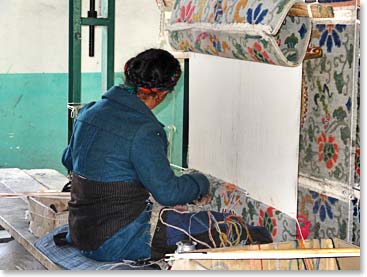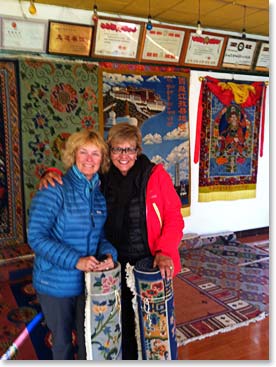
Seven Days in Tibet Expedition Dispatch
November 3, 2012 – Gyantse to Shigatse
Much as we have learned about monasteries, and as interesting as they are, we asked our guide, Mr. Pingtso La to find us something to occupy us in addition to the monasteries.

The speed and skill of the weavers was impressive.
Before we left Gyantse, he took us to a carpet factory. Carpets made in Gyantse are the best quality in Tibet. Mr Pingtso La told us this and we have no reason to doubt him. He knows a lot. The factory was a series of one story buildings. In one building, wool was carded and spun, in another died and there were several workshops where the carpets are woven. We visited one of the workshops and were impressed by the speed with which the weavers worked and by how beautiful their output is. You can order custom products and we saw custom floor mats for cars, for example. In the restaurants, you sit on benches that are upholstered in carpets. These are made here, as well.
Sharon and I were so impressed by the beautiful carpets, that we are coming home with one each.

Wendy and Sharon were so impressed that
they each made a purchase.
The beautiful fertile valley between Gyantse and Shigatse is the richest in Tibet and here the farmers are the wealthiest. We drove by rich farmland, the fields full of cattle, goats, sheep, pigs, horses and yaks. The new green of winter wheat dusted the grey soil. The road was busy with people and tractors and horse carts and there is a feeling of prosperity in this region. Both small tractors and animals are used to plow the fields.
The women, in traditional dress, watch Sharon and I as we take pictures or just stretch our legs. We watch them, as well.
Everywhere, stuck against the sides of stone fences and houses are patties of yak dung drying for winter fuel. Thousands of them. It’s first come first served in the yak dung department. Anyone can collect it anywhere. Unless it is in your own courtyard. Then no one else can take it. The contrast between electrical cables and satellite dishes and solar panels and drying dung reflects the contrast between old and new Tibet.
Further down the road we visited a barley mill. The miller had a series of sluices through which the water ran that powered the grinder. It was an effective and low tech way to grind barley, which is one of the basic crops, here. The air was full of barley flour and within minutes we were all covered with it.
We left the river valley and climbed up into Shigatse. Here we get our alien card (this is a new rule since our arrival and we are now officially aliens. I always knew this to be true about Gerry, but the rest of us?). This is the second biggest city in Tibet and has all the characteristics of Lhasa. It looks like a modern Chinese city. Our hotel, the best one in Shigatse, is a government hotel, and is where the government officials stay. Outside of Lhasa, there are no real luxury hotels but this is a nice one and has hot water in some rooms sometimes.
After we checked in and had lunch we went to the Monastery. This is one of the holiest places in Tibet and is the place of the stupa of the the Tenth Panchen Lama. Another 547 kgs of gold and 1000 gems (I know I may appear hung up on this, but this is a lot of gold in a poor country). We visited all of the areas of this monastery. In this monastery, we could take pictures and so we did. Some of the beautiful decoration and murals and, yes, the stupa, are unique examples of Tibetan art. I love the colors. When I saw this kind of art in northern India, I knew I wanted to come to Tibet.

